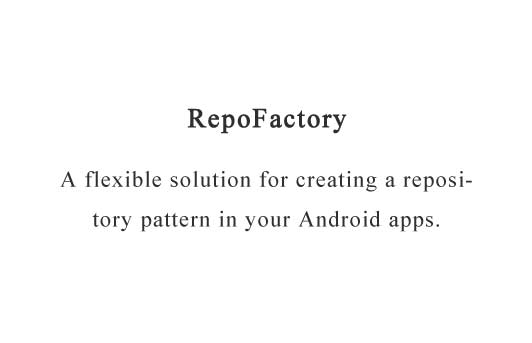A flexible solution for creating a repository pattern in your Android apps

RepoFactory
A flexible solution for creating a repository pattern in your Android apps.
Based on RxJava and Retrofit you can either instantiate a ready-made one or build your own.
Getting started
The idea behind this library is to provide a simple way to instantiate a repository pattern, providing a parameter to define the type of repository.
The following steps describe how to implement a ready-made repository pattern.
1) Define type of data involved
a. model returned by the endpoint call, the same class will be used for caching the response - <M> in the code
b. any parameters required for the endpoint call - <P> in the code. It can be Void if no params are required.
In case of multiple parameters, then Pair or Triple (from Kotlin or java) can be used, or any other Tuple defined in other libraries.
The only limitation is that methods equals and hashCode must be overridden.
This is because this class will be used as key for the HashMap that handles the cache.
c. type of repository chosen. Currently it can be:
- NO_CACHE: the repository simply triggers a network call for each request
- SINGLE_LEVEL_CACHE: a one-level memory cache is present and will be used until the response associated with a specific value of parameters doesn't expire
2) Instantiate the factory and declare a Repository<return_type, parameters>
private final RepoFactory repoFactory = new RepoFactory();
private final Repository<ForecastResponse, String> weatherForecastRepo;
3) Instantiate the repository defining the endpoint call
weatherForecastRepo = repoFactory.createRepo(RepoType.SINGLE_LEVEL_CACHE,
location -> interfaceApi.getForecast(location);
4) Define the Single to which subscribe
public Single<ForecastResponse> getForecast(String location) {
return weatherForecastRepo.get();
}
Custom implementations
If any part of the architecture needs to be customised for specific needs - either the network datasource or the cache or the repository itself - the RepoFactory class can be derived and its method overridden as required.
See RepoFactory.java for more info.
Gradle
Add the JitPack repository in your root build.gradle at the end of repositories:
allprojects {
repositories {
...
maven { url 'https://jitpack.io' }
}
}
Add the dependency
dependencies {
implementation 'com.github.guidovezzoni:repofactory:1.0.0'
}
Additional features
These features are likely to be included in future releases:
- 3 level cache
- periodical removal of expired cache
Known Issues
Cache validity setup
The Repository interface doesn't give access to setCacheValidity() so currently the only way to do that is
((SingleLevelCacheRepository) weatherForecastRepo).setCacheValidity(TimeUnit.MINUTES.toMillis(1));
I'm still figuring out the best way to do it
Usage of non hashable classes
When parameter <P> uses a class for which methods equals and hashCode have not been overridden, cache won't work properly.
Expired cache entries are not removed
Expired cache entries can build up in time if the parameters change frequently and values are not refreshed
Bugs and Feedback
For bugs, questions and discussions please use the GitHub Issues .
History
| Version | Date | Notes |
|---|---|---|
| 1.0.0 | 01/05/2019 | First Release |
| 0.1.2_alpha | 01/05/2019 | Minor changes, documentation improvements |
| 0.1.1_alpha | 28/04/2019 | Fixed: network call always executed |
| 0.1.0_alpha | 26/04/2019 | First alpha release |